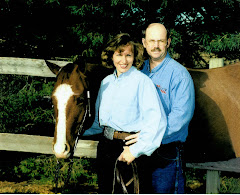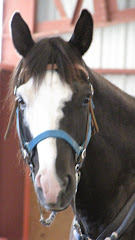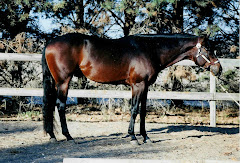June 12, 2009
Sometimes, when you are at an event for 3, 4 days, you get drained, and you wished it was over. But Day 3 and everyone is still pumped. No one is even talking like they are brain dead or exhausted. We actually want to ride longer!
Today, in discussion time, we talked about Hind Leg Engagement. The hind leg needs to reach up and under the horse. When the hind leg isn’t engaged, the horse sit’s the foot down and it pushes backward, which is undesirable. The muscles of the back and abdomen need to be strengthen. The back needs to be pushed up from below, (which aids collection).
We discussed further about the Back Peddling motion that we should feel as the horse is moving. Think about the hind leg coming forward. Think about making a circle from the wither to the hind leg. I envisioned a basket ball rotating in my hand, backwards, and I finally got it! I could picture the motion of the horse moving from the withers backwards, down the back to the tail, to the hind legs, and finally being propelled front wards, towards the abdomen. (This is from riding western pleasure horses, and I was taught to push the hind end in, having the horse push off the outside hind to push into the lope). Knowing that the movement comes from the hind legs and comes forward, and learned to see this as the END of the circle and not the start. The START is at the top, backwards and down, then circling back up. I finally got it after a previous 2 day clinic and the 2 previous days here!
With back peddling, we push into contact. This helps to loosen up the hip joints of the horse. We don’t want forward peddling as this could shove the shoulders into the ground (thinking forward and down into the front legs).
With the “Following Seat” motion, we should feel the movement in our knees. Try counting footfalls to feel each separate foot fall. Learn to feel when each hoof hit’s the ground. Learn the feel between the front leg movement and the hind leg movement.
As an instructor, Sally Swift talked about putting 75% of the attention on SELF and only 25% on the student! She said to put 75% on SELF and the other 25% on the horse! If you did these things to yourself, then they would project to the student or to your horse.
Remember to distance yourself from the rider, and the rider’s issues or the horse’s issues, by centering yourself. Don’t allow yourself to be drained. Yet remember to teach from the positive! Teach by centering yourself, be clear, have balance, and be grounded.
Develop an independent seat and an independent balance to have independent hands and arms. A lot of what we learn comes easier as we learn to breathe deeply. Breathe through the entire rib cage and diaphragm. Breathe, as this is how a horse communicates with each other. Therefore, it is important to learn the horse’s language. Understand and respect their nature. Learn what worries them, what makes them happy, what makes them content, what they need.
Breathing helps to calm the horse, and breathing calms us, too! Use breathing as an aid. If you prepare yourself with deep breathing before you ask something of the horse or ask the horse to do something, then the horse will think that you are ok and he does not need to be scared or alarm.
Breathe. Exhale. Drop down into your center. Find your center! Now, breathe, center, AND grow. Grow longer, like a tree that grows deep roots. Growing longer could feel like a half halt to the horse, preparing the horse for something to come. Half halts can be used to wisely prepare ourselves to do something with the horse, or even used whenever we just need to calm ourselves. (even during the hustle and bustle of a busy day!) Half halts can be used to re-center ourselves. Half halts can be our center to regain balance, power, control, peace, calmness, of whatever we need it to be!
Day 3 Riding. We reviewed. We continued to walk and trot while within our bubble. With a leader, and with closed eyes, we concentrated on our “Following Seat”. In 2 point position, we placed our hands on the horse’s shoulder to feel the horse’s movement. Our body is comparable to the horse, and as certain parts of our body moves, so does the coordinating part of the horse moves.
We continued to work on centering ourselves. As the rider, we placed one hand in front of our navel and one behind our back at the same height as the front hand. We rocked our pelvis to find our neutral pelvis. We trotted, found our center, and rode in our bubble. We worked on trot to walk to trot transitions.
To grow into our center, at the walk, we raised one hand into the air. We took our foot out of the stirrup to stretch and grow from our center. Right hand up and right leg reaching down. We repeated the exercise on the other side. Breathe. Center. Grow.
In conclusion of the first part of the first Instructor’s Clinic, we were reminded to read and teach by the Code of Conduct, as Sally Swift taught by. The group will each become individual teachers, becoming 1 of over 800 Centered Riding Instructors.
Sally believed in life long learning! She would want us to continue to grow and learn. Learn from your experience. Learn from everywhere.
Sally is gone now, but her legacy lives on in the style of riding that she taught and lived by. She was, and will always remain, the heart and soul behind Centered Riding. Through her wisdom, she will teach each of us to be a better rider and develop a centered seat. Come along on the ride with me!
Turning Night to Day
9 years ago







No comments:
Post a Comment